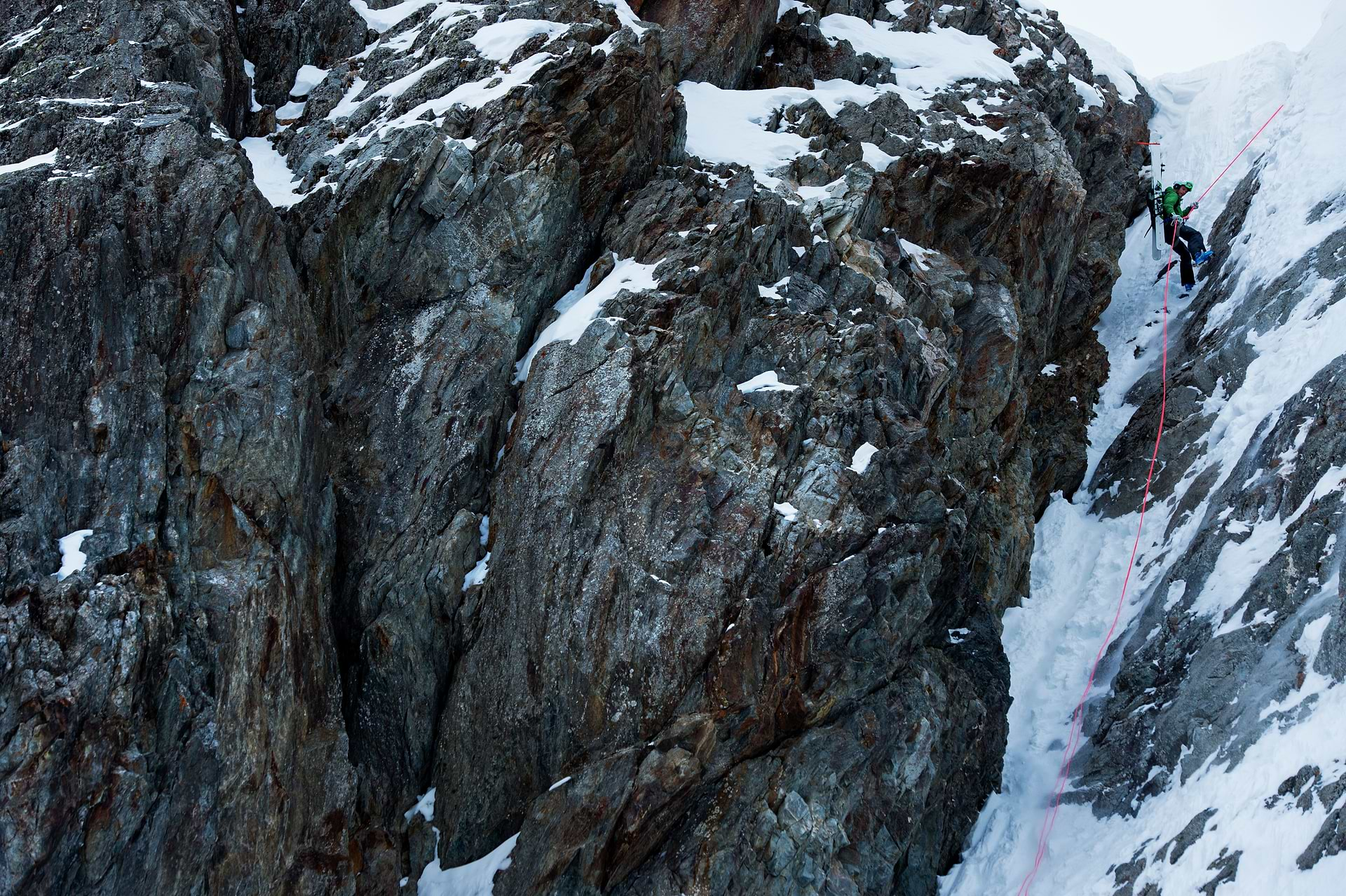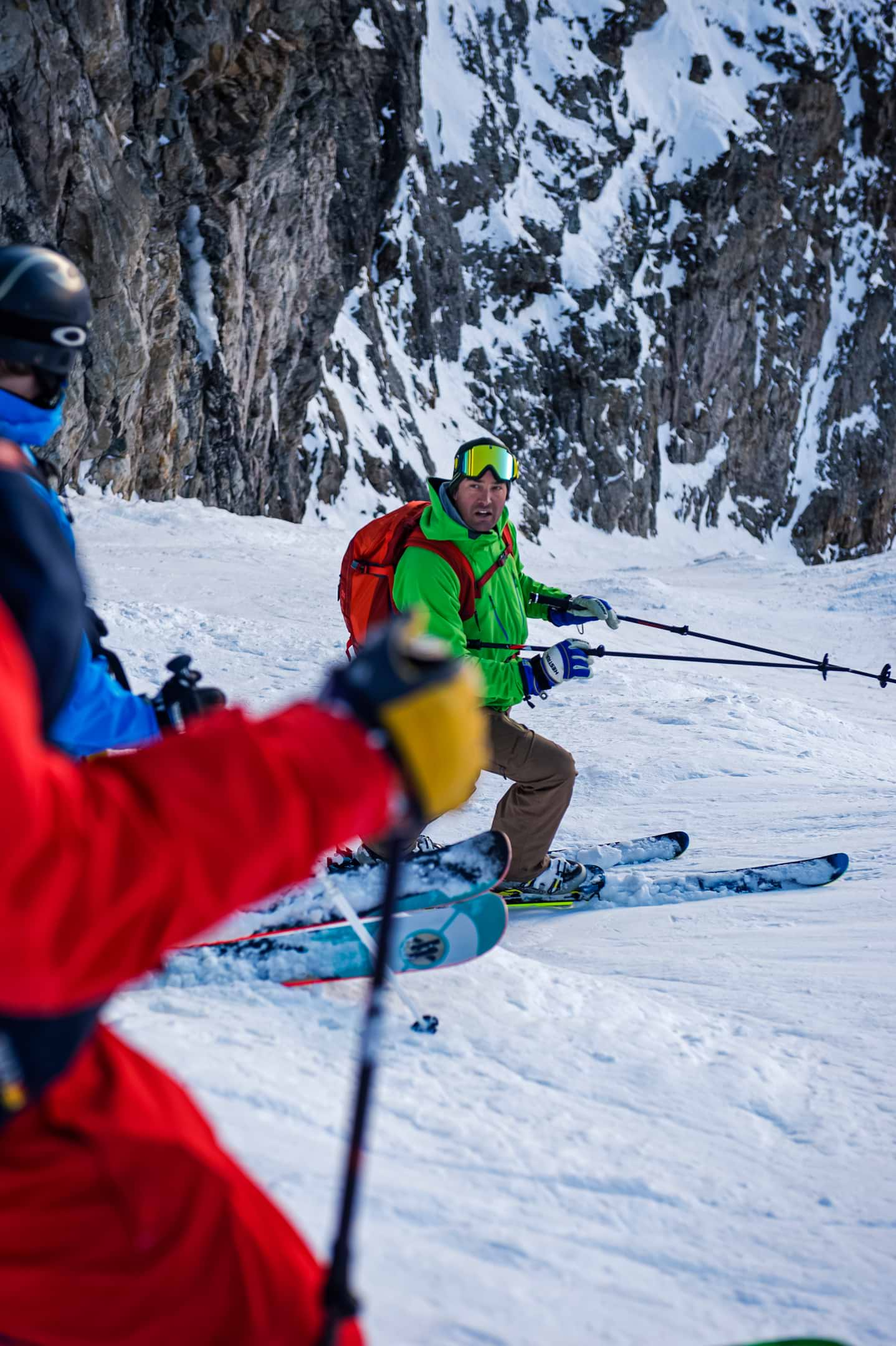
La Grave, France
How to navigate the Shangri-La of freeride.
Pow Guides
Words by: Josefine Ås
Photos by: Mattias Fredriksson
The word mythical,
so often overused, may be the most apt description for the aura surrounding the small French village of La Grave and its daunting north-facing mountain La Meije. The renowned ski destination of the southern French Alps is unlike any other: a 40-year-old téléphérique carries intrepid skiers up from the rustic village (1,480m / 4,855 feet) to a spectacular, alpine world (3,211m / 10,534 feet). Stepping out at “3,200” (as everyone calls the top station), there’s not a groomer in sight. La Grave’s ski patrol exists to informskiers and snowboarders about the snow conditions and potential dangers; they do not supervise descents or bomb slopes for avalanche control. Featuring 2,000 meters (6,600 feet) descents in natural big mountain terrain with glaciers, open bowls, infamous couloirs, and steep larch tree skiing, skiers bear responsibility for the risk and reward of their line choices.
La Grave does not pretend it has something for everyone but come well-prepared with a humble attitude, and it can offer some of the best freeriding on the planet.



The alpine adventure - La Voûte
Vertical drop: 2,400 meters (7,900 feet)
A well-kept secret for ages, La Voûte has recently become one of the most legendary itineraries of La Grave—the definition of a ski adventure and a bucket list experience. The couloir is one of the most spectacular, sustained, and varied lift-accessed descents in the world. The route starts on the gentler slopes of the glacier before narrowing and steepening significantly. Route finding is complex. Don’t follow tracks, especially on this part of the mountain! Locals know how to navigate the complex, exposed terrain, but some of them use tricks that we—mere mortals—can’t follow. An adrenalin rush waits almost halfway down the route: a mandatory 30–40 meter rappel into a massive couloir. Rumor has it you can find crystals hidden in the side walls. After, zig-zag your way through rocks and trees to the road. Hitchhike back to the village or pre-park a car below the tunnel.
Several similar descents down to the road on this wild part of the mountain humble even the most expert skiers. The descents are exposed to avalanches or dangerous falls, so they are not recommended if the conditions aren’t right. Hire a local mountain guide for route finding and local knowledge.



The panoramic backside - St Christophe
Vertical drop: 2,128 meters ( 6,982 feet)
When conditions are right, and you’re up for a full day’s panoramic adventure, head up to the top of the mountain, Dôme de la Lauze (3568 m/11706 ft). Drop the backside and ski the south-facing Vallon de la Selle down to the remote village of St-Christophe-en-Oisans at 1440 meters. Descending more than 2000m, the run to the Vénéon valley is one of the most beautiful on the planet. Your backdrop is Barre des Ecrins, the highest peak in the mountain range at 4,102 meters (13,458 feet). The south-facing line ought to be skied in stable early-season powder or late-season corn. The top section is the steepest and can be intimidating in challenging conditions. The 1,000-meter-wide open bowl of 35-40 degrees eases out to a beautiful flow down to the valley below. Follow the valley for about five kilometers, surrounded by steep walls on both sides until you end up in the ancient village of St Christophe. Do yourself a favour and enjoy lunch at the only restaurant, La Cordée. The owner, Marie-Claude Turc, is not only charismatic, but the food is delicious. Make sure to top off your meal with one of Marie-Claude’s exceptional “tartes” before calling a taxi or a friend to take you back to La Grave, approximately 45 minutes by car.

Local mountain guide Per Ås inform his clients about the current conditions.

Ex-Freeride World Champion, Henrik Windstedt, always makes it look easy.

Daniel and Annie Philippe greet you at Refuge Chancel.
Classic left side - Patou Couloir
Vertical drop: 200 meters / 656 feet
La Grave has two classic and prominent descents: one on each side from Col de Ruillans—the top of the cable car station. Skier’s left, following the Chancel valley, presents likely the mellowest way down the mountain. Around the mid-section, you can opt for more adrenaline-prone lines by choosing one of three couloirs leading down to the Puy Vachier lake. The Patou couloir has the most complex route finding—don’t attempt on a foggy day as you traverse an exposed rock band to get there. However, the couloir itself is a picture-perfect straight line cut between high rock walls, with the optimal steepness of about 40 degrees, offering a nice but manageable adrenaline rush. In good snow, you can carve quality turns down the chute towards the lake before descending through the trees for another run.
On your next lap, pick a different couloir down to the lake and stop for lunch at the Refuge Chancel. As you eat, you can admire your previous turns down the Patou from an angle where it looks vertical!

Trifide 1 is the Shangri La of couloir skiing. Jon Larsson hits it in perfect conditions, just as the last light reflects off La Meije.

Classic right side – Trifide 1
Vertical drop: 750 meters / 2,460 feet
Heading right from the top of the cable car station, you’ll end up in the Vallons de la Meije and the most classic descent of La Grave beneath the iconic summit of La Meije towering above at 3,983 meters (13,068 feet). The mighty glaciers and the valley’s northerly aspect help preserve the snow quality. There is a variety of—the most technical being the notorious Trifide couloirs (Trifide 1 being the most obvious). The couloir is visible while riding the cable car, which can offer beta about the conditions. (Has it avalanched? Is it tracked?) The top entrance—at around 3,000m—has become trickier over the years, with shallow snow often requiring a jump or rappel over rocks into a greater than 40-degree chute. To avoid the upper part, most riders opt for the less risky side entrance to the couloir. The views over the massive Meije and Rateau glaciers will blow you away. But hold on: once in the couloir, you need to leave the views and concentrate on your turns with a sustained 40+ degrees, 750m descent. In unfavourable conditions, a fall could be serious. As the couloir is easy to access from the lift, it has an unfortunate deadly reputation for skiers misjudging snow conditions and the seriousness of the descent. But in the right conditions, Trifide 1 is the Shangri La of couloir skiing, with spectacular views and a perfect angle for exciting skiing.
Seriously consider skiing with a mountain guide for a safer and more fun experience. The local guides know the area and where the good snow is. There are a couple of guide offices in La Grave, as well as independent mountain guides.
www.guidelagrave.com | www.peras.se | www.skierslodge.com | www.snowlegend.com | www.provallone.com

JOSEFINE ÅS is a Swedish freelance journalist and PR manager living in the southern French Alps. Off-piste skiing and ski touring off the beaten path is a lifelong passion and a big part of her daily winter life. She enjoys exploring her new hoods around Serre Chevalier and her old hoods in La Grave, just a few kilometers away.
RELATED STORIES